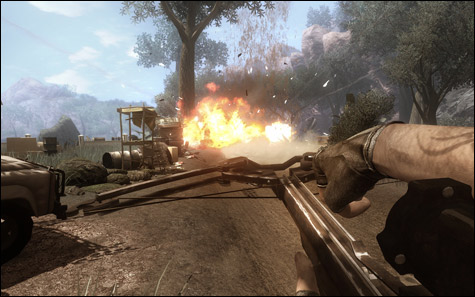
PANORAMA: Far Cry 2 let you blow everything up real good, but scope and scale made it special. |
This was a strange year for video games. We were treated to one solid release after another, month after month, with no dry spells. There were no real stinkers, games either ineptly made or cynically conceived. Yet even the best releases seemed to have trouble getting out of their own way, offering scenes of awe and moments of frustration in equal measure. In the end, most of 2008's best games succeeded on the strength of their settings. From a bustling New York City to a barren, post-nuclear DC to the expansive plains of Africa, what gamers may end up remembering about this year isn't what we did but where we did it.
Rock Band 2 | MTV Games
Sometimes, picking your favorite game of the year comes down to one simple question: which was the most fun to play? In this regard, Rock Band 2 (Xbox 360, PlayStation 3, PlayStation 2, Wii) had no peers. You can play it for five minutes or five hours, by yourself or in a room full of people. Newcomers with no sense of rhythm can enjoy themselves as much as the expert who plays with the guitar behind his head. And given Harmonix's commitment to releasing wide-ranging, high-quality downloadable content on a weekly schedule, this could be the last music game you'll ever need.

Crisis Core: Final Fantasy VII | Square Enix
When a developer mines its most historically popular franchises, there's always the danger that the result will rely too much on our warm and fuzzy memories and not enough on creating a compelling new experience. That wasn't the case with Crisis Core (PlayStation Portable), a prequel to Square's mega-popular Final Fantasy VII. It coupled a moving new storyline with lean, mean, role-playing mechanics and set them against familiar backdrops like Midgar and Nibelheim. Crisis Core was the total package — and on a handheld system, to boot!
Braid | Microsoft
Developed by the two-man team of designer Jonathan Blow and artist David Hellman, Braid (Xbox Live Arcade) was the kind of bold, risk-taking venture you'd never find from a major studio. Although it looked like a throwback to the era of the side-scrolling platformer, Braid's twisted timelines and mind-blowing temporal puzzles were more forward-thinking than any of the year's big-budget offerings. Add to that a haunting storyline that gradually revealed itself to be a meditation on memory and regret and you had a rarity: a video game with the courage to take itself seriously.
Far Cry 2 | Ubisoft
Far Cry 2 (Xbox 360, PlayStation 3, PC) succeeded as a pure shooter, with intense, prolonged gunfights and big action setpieces that let you blow everything up real good. But its scope and its sense of scale made it special. Its story, about various mercenaries playing both sides of a civil war against the middle, was delivered without irony or comic relief. And its panoramic African landscape was hypnotic and easy to lose yourself in. Rarely has a game's setting been as gorgeous, as seductive, or, in the end, as ruinous for everyone who set foot there.
Left 4 Dead | Valve Software
The optimal way to succeed in Left 4 Dead (Xbox 360, PC) is to find teammates you know and trust, so that you all look out for one another, sharing resources and covering your comrades' backs as you battle against thousands of ravenous zombies. But it's more interesting to hop into a game with three strangers and see how the group dynamic reveals itself. Some are leaders, some are followers; some are selfless and some are selfish. The reason each new playthrough feels fresh isn't the capriciousness of the AI Director — it's because, despite your best intentions, in Left 4 Dead you can't help being yourself.
Fallout 3 | Bethesda Softworks
Oh boy, did Fallout 3 (Xbox 360, PlayStation 3, PC) have problems. Buggy, bloated, and full of bizarre quirks, it also gave us one of the most compelling and fully realized game worlds ever built. It's simply impossible not to get sidetracked by the endless tempting locations you encounter along your path — some based on real-life landmarks, some part of Fallout lore. The moment you first emerge from Vault 101 and gaze upon the vast wasteland, which includes the burned-out husks of the Capitol and the Washington Monument on the horizon, is unforgettable.
No More Heroes | Ubisoft
No More Heroes (Wii) was a punk manifesto in video-game form. It was created by the iconoclastic Suda 51 and his team at Grasshopper Manufacture, and its reckless appropriation of symbols and tropes from games of all genres showed no regard for manners or civility. Potty humor, over-the-top gore, and juvenile sexuality came together to create an irresistible one-of-a-kind. Like its hero, an ambitious hitman named Travis Touchdown, No More Heroes seemed to be in love with the very notion of its own existence.